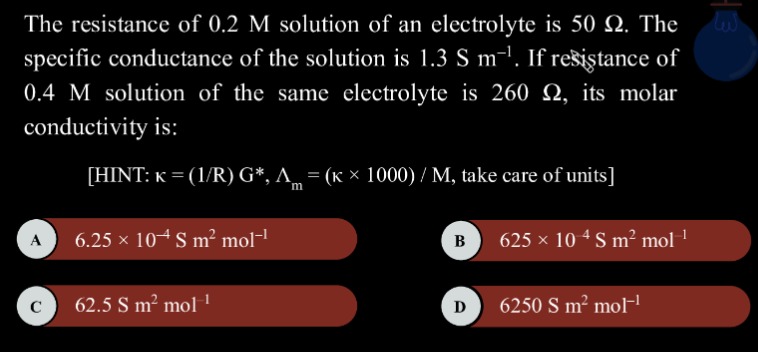Question
Question: The resistance of 0.2 M solution of an electrolyte is 50 Ω. The specific conductance of the solution...
The resistance of 0.2 M solution of an electrolyte is 50 Ω. The specific conductance of the solution is 1.3 S m⁻¹. If resistance of 0.4 M solution of the same electrolyte is 260 Ω, its molar conductivity is:
[HINT: κ = (1/R) G*, \Lambda$$_{m} = (κ × 1000) / M, take care of units]

6.25 × 10⁻⁴ S m² mol⁻¹
6.25 × 10⁻² S m² mol⁻¹
62.5 S m² mol⁻¹
625 × 10⁻⁴ S m² mol⁻¹
6.25 × 10⁻⁴ S m² mol⁻¹
Solution
Here's how to solve this problem:
-
*Calculate the cell constant (G)**:
Using the data for the 0.2 M solution:
κ1=(1/R1)G∗
1.3Sm−1=(1/50Ω)G∗
G∗=1.3Sm−1×50Ω=65m−1
-
Calculate the specific conductance (κ2) of the 0.4 M solution:
κ2=(1/R2)G∗
κ2=(1/260Ω)×65m−1
κ2=0.25Sm−1
-
Calculate the molar conductivity (Λm2) of the 0.4 M solution:
Λm=κ/C, where C is the molar concentration in molm−3.
Convert molarity from molL−1 to molm−3:
C2=0.4molL−1×1000Lm−3=400molm−3
Λm2=κ2/C2
Λm2=0.25Sm−1/400molm−3
Λm2=6.25×10−4Sm2mol−1
Therefore, the molar conductivity of the 0.4 M solution is 6.25×10−4Sm2mol−1.
